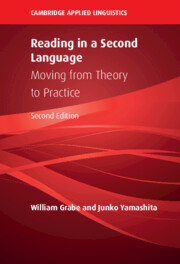Book contents
- Reading in a Second Language
- The Cambridge Applied Linguistics Series
- Reading in a Second Language
- Copyright page
- Dedication
- Contents
- Figures
- Tables
- Preface
- Part I Foundations of Reading
- Part II Patterns of Variation in Reading
- Part III Developing Reading Comprehension Abilities
- 11 Vocabulary and Reading Comprehension
- 12 Building Main Idea Comprehension: Syntax and Strategies
- 13 Becoming a Strategic Reader
- 14 Building Awareness of Discourse Structure
- Part IV Expanding Reading Comprehension Skills
- Part V Applications of Reading Research: Instruction and Assessment
- References
- Author Index
- Subject Index
14 - Building Awareness of Discourse Structure
from Part III - Developing Reading Comprehension Abilities
Published online by Cambridge University Press: 01 September 2022
- Reading in a Second Language
- The Cambridge Applied Linguistics Series
- Reading in a Second Language
- Copyright page
- Dedication
- Contents
- Figures
- Tables
- Preface
- Part I Foundations of Reading
- Part II Patterns of Variation in Reading
- Part III Developing Reading Comprehension Abilities
- 11 Vocabulary and Reading Comprehension
- 12 Building Main Idea Comprehension: Syntax and Strategies
- 13 Becoming a Strategic Reader
- 14 Building Awareness of Discourse Structure
- Part IV Expanding Reading Comprehension Skills
- Part V Applications of Reading Research: Instruction and Assessment
- References
- Author Index
- Subject Index
Summary
Chapter 14: Building Awareness of Discourse Structure. Skilled readers are tuned into how information is organized, how central themes emerge, and how signaling mechanisms provide cues to this organization. Skilled readers are able to identify the main or topic sentences as they appear in a text and are sensitive to text structures that help identify where to find main idea sentences. The chapter sorts written discourse analysis into two distinct approaches. The first examined specific aspects of the texts themselves, describing the roles of cohesion, information structuring, lexical signaling, anaphoric signaling, topic continuity signaling, text coherence, text genres, and patterns of discourse organization that underlie all prose texts. The second approach involves a focus on intentional inferencing skills and “deep comprehension.” The chapter then reviews research on discourse structure and reading comprehension in both L1 and L2 contexts. It also focuses specifically on the importance of using discourse sensitive graphic organizers. The chapter then describes research on teaching discourse structure awareness, and concludes with implications for instruction.
Keywords
- Type
- Chapter
- Information
- Reading in a Second LanguageMoving from Theory to Practice, pp. 338 - 368Publisher: Cambridge University PressPrint publication year: 2022

